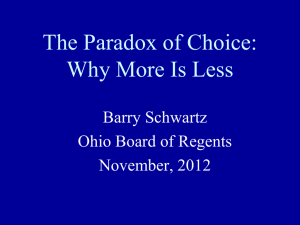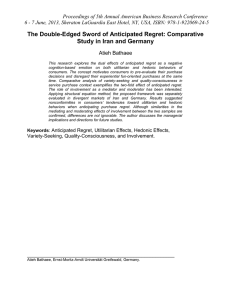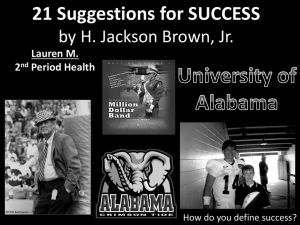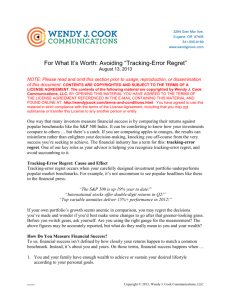Efficiently Eliciting Preferences from a Group of Users
advertisement
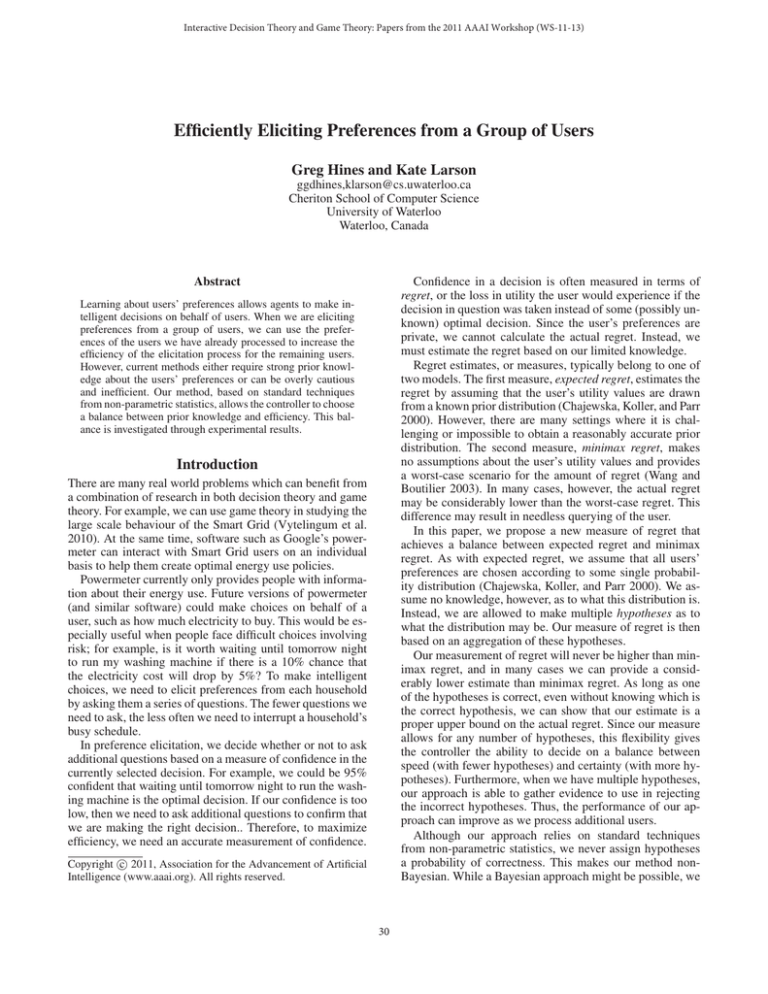
Interactive Decision Theory and Game Theory: Papers from the 2011 AAAI Workshop (WS-11-13)
Efficiently Eliciting Preferences from a Group of Users
Greg Hines and Kate Larson
ggdhines,klarson@cs.uwaterloo.ca
Cheriton School of Computer Science
University of Waterloo
Waterloo, Canada
Confidence in a decision is often measured in terms of
regret, or the loss in utility the user would experience if the
decision in question was taken instead of some (possibly unknown) optimal decision. Since the user’s preferences are
private, we cannot calculate the actual regret. Instead, we
must estimate the regret based on our limited knowledge.
Regret estimates, or measures, typically belong to one of
two models. The first measure, expected regret, estimates the
regret by assuming that the user’s utility values are drawn
from a known prior distribution (Chajewska, Koller, and Parr
2000). However, there are many settings where it is challenging or impossible to obtain a reasonably accurate prior
distribution. The second measure, minimax regret, makes
no assumptions about the user’s utility values and provides
a worst-case scenario for the amount of regret (Wang and
Boutilier 2003). In many cases, however, the actual regret
may be considerably lower than the worst-case regret. This
difference may result in needless querying of the user.
In this paper, we propose a new measure of regret that
achieves a balance between expected regret and minimax
regret. As with expected regret, we assume that all users’
preferences are chosen according to some single probability distribution (Chajewska, Koller, and Parr 2000). We assume no knowledge, however, as to what this distribution is.
Instead, we are allowed to make multiple hypotheses as to
what the distribution may be. Our measure of regret is then
based on an aggregation of these hypotheses.
Our measurement of regret will never be higher than minimax regret, and in many cases we can provide a considerably lower estimate than minimax regret. As long as one
of the hypotheses is correct, even without knowing which is
the correct hypothesis, we can show that our estimate is a
proper upper bound on the actual regret. Since our measure
allows for any number of hypotheses, this flexibility gives
the controller the ability to decide on a balance between
speed (with fewer hypotheses) and certainty (with more hypotheses). Furthermore, when we have multiple hypotheses,
our approach is able to gather evidence to use in rejecting
the incorrect hypotheses. Thus, the performance of our approach can improve as we process additional users.
Although our approach relies on standard techniques
from non-parametric statistics, we never assign hypotheses
a probability of correctness. This makes our method nonBayesian. While a Bayesian approach might be possible, we
Abstract
Learning about users’ preferences allows agents to make intelligent decisions on behalf of users. When we are eliciting
preferences from a group of users, we can use the preferences of the users we have already processed to increase the
efficiency of the elicitation process for the remaining users.
However, current methods either require strong prior knowledge about the users’ preferences or can be overly cautious
and inefficient. Our method, based on standard techniques
from non-parametric statistics, allows the controller to choose
a balance between prior knowledge and efficiency. This balance is investigated through experimental results.
Introduction
There are many real world problems which can benefit from
a combination of research in both decision theory and game
theory. For example, we can use game theory in studying the
large scale behaviour of the Smart Grid (Vytelingum et al.
2010). At the same time, software such as Google’s powermeter can interact with Smart Grid users on an individual
basis to help them create optimal energy use policies.
Powermeter currently only provides people with information about their energy use. Future versions of powermeter
(and similar software) could make choices on behalf of a
user, such as how much electricity to buy. This would be especially useful when people face difficult choices involving
risk; for example, is it worth waiting until tomorrow night
to run my washing machine if there is a 10% chance that
the electricity cost will drop by 5%? To make intelligent
choices, we need to elicit preferences from each household
by asking them a series of questions. The fewer questions we
need to ask, the less often we need to interrupt a household’s
busy schedule.
In preference elicitation, we decide whether or not to ask
additional questions based on a measure of confidence in the
currently selected decision. For example, we could be 95%
confident that waiting until tomorrow night to run the washing machine is the optimal decision. If our confidence is too
low, then we need to ask additional questions to confirm that
we are making the right decision.. Therefore, to maximize
efficiency, we need an accurate measurement of confidence.
c 2011, Association for the Advancement of Artificial
Copyright Intelligence (www.aaai.org). All rights reserved.
30
discuss why our method is simpler and more robust.
Minimax Regret When there is not enough prior information about users’ utilities to accurately calculate expected
regret, and in the extreme case where we have no prior information, an alternative measure to expected regret is minimax
regret. Minimax regret minimizes the worst-case regret the
user could experience and makes no assumptions about the
user’s utility function.
To define minimax regret, we first define pairwise maximum regret (PMR) (Wang and Boutilier 2003). The PMR
between decisions d and d is
The Model
Consider a set of possible outcomes X = [x⊥ , . . . , x ]. A
user exists with a private utility function u. The set of all
possible utility functions is U = [0, 1]|X| . There is a finite
set of decisions D = [d1 , . . . , dn ]. Each decision induces a
probability distribution over X, i.e., Prd (xi ) is the probability of the outcome xi occurring as a result of decision d. We
assume the user follows expected utility theory (EUT), i.e.,
the overall expected utility for a decision d is given by
Pr(x)u(x).
EU (d, u) =
x∈X
P M R(d, d , C) = max {EU (d , u) − EU (d, u)} .
u∈C
(2)
The PMR measures the worst-case regret from choosing decision d instead of d . The PMR can be calculated using linear programming. PMR is used to find a bound for the actual
regret, r(d), from choosing decision d, i.e.,
d
Since expected utility is unaffected by positive affine transformations, without loss of generality we assume that
u : X → [0, 1] with u(x⊥ ) = 0 and u(x ) = 1.
Since the user’s utility function is private, we represent
our limited knowledge of her utility values as a set of constraints. For the outcome xi , we have the constraint set
P M R(d, d , C),
r(d) ≤ M R(d, C) = max
d ∈D
(3)
where M R(d, C) is the maximum regret for d given C. For
a given C, the minimax decision d∗ guarantees the lowest
worst-case regret, i.e.,
[Cmin (xi ), Cmax (xi )],
which gives the minimum and maximum possible values for
u(xi ), respectively. The complete set of constraints over X
is C ⊆ U.
To refine C, we query the user using standard gamble queries (SGQs) (Keeney and Raiffa 1976). SGQs ask
the user if they prefer the outcome xi over the gamble
[1 − p; x⊥ , p; x ], i.e., having outcome x occur with probability p and otherwise having outcome x⊥ occur. By EUT,
if the user says yes, we can infer that u(xi ) > p. Otherwise,
we infer that u(xi ) ≤ p.
d∗ (C) = arg min M R(d, C).
d∈D
(4)
The associated minimax regret is (Wang and Boutilier 2003)
M M R(C) = min M R(d, C).
d∈D
(5)
Wang and Boutilier argue that in the case where we have no
additional information about a user’s preferences, we should
choose the minimax decision (Wang and Boutilier 2003).
The disadvantage of minimax regret is that it can overestimate the actual regret, which can result in unnecessary
querying of the user. To investigate this overestimation, we
created 500 random users, each faced with the same 20 outcomes. We then picked 10 decisions at random for each user.
Each user was modeled with the utility function
Types of Regret
Regret, or loss of utility, can be used to help us choose a decision on the user’s behalf. We can also use regret as a measure of how good our choice is. There are two main models
of regret which we describe in this section.
u(x) = xη , x ∈ X
Expected Regret Suppose we have a known family of potential users and a prior probability distribution, P , over U
with respect to this family. In this case, we can sample from
P , restricted to C, to find the expected utility for each possible decision. We then choose the decision d∗ which maximizes expected utility. To estimate the regret from stopping
the elicitation process and recommending d∗ (instead of further refining C), we calculate the expected regret as (Chajewska, Koller, and Parr 2000)
[EU (d∗ , u) − EU (d, u)]P (u)du.
(1)
(6)
with η picked uniformly at random between 0.5 and 1. Equation 6 is commonly used to model peoples’ utility values in
experimental settings (Tversky and Kahneman 1992). Table
1 shows the mean initial minimax and actual regret for these
users. Since Equation 6 guarantees that each users’ utility
values are monotonically increasing, one possible way to
reduce the minimax regret is to add a monotonicity constraint to the utility values in Equation 2. Table 1 also shows
the mean initial minimax and actual regret when the monotonicity constraint is added. Without the monotonicity constraints, the minimax regret is, on average, 8.7 times larger
than the actual regret. With the monotonicity constraints,
while the minimax regret has decreased in absolute value,
it is now 15.4 times larger than the actual regret.
It is always possible for the minimax regret and actual regret to be equal. The proof follows directly from calculating
the minimax regret and is omitted for brevity. This means
that despite the fact that the actual regret is often considerably less than the minimax regret, we cannot assume this to
C
The disadvantage of expected regret is that we must have
a reasonable prior probability distribution over possible utility values. This means that we must have already dealt with
many previous users whom we know are drawn from the
same probability distribution as the current users. Furthermore, we must know the exact utility values for these previous users. Otherwise, we cannot calculate P (u) in Equation
1.
31
Regret
Minimax
Actual
Nonmonotonic
0.451
0.052
Monotonic
0.123
0.008
sion d restricted to the utility constraints C. We can calculate
Fd,H∗ |C (r) using a Monte Carlo method. In this setting, we
define the probabilistic maximum regret (PrMR) as
−1
P rM R(d, H∗ |C , p) = Fd,H
∗ | (p),
C
Table 1: A comparison of the initial minimax and actual regret for users with and without the monotonicity constraint.
(7)
for some probability p. That is, with probability p the maximum regret from choosing d given the hypothesis H∗ and
utility constraints C is P rM R(d, H∗ |C , p). The probabilistic minimax regret (PrMMR) is next defined as
always be the case. Furthermore, even if we knew that the
actual regret is less than the minimax regret, to take advantage of this knowledge, we need a quantitative measurement
of the difference. For example, suppose we are in a situation
where the minimax regret is 0.1. If the maximum actual regret we can tolerate is 0.01, can we stop querying the user?
According to the results in Table 1, the minimax regret could
range from being 8.7 times to 15.4 times larger than the actual regret. Based on these values, the actual regret could be
as large as 0.0115 or as small as 0.006. In the second case,
we can stop querying the user and in the first case, we cannot. Therefore, a more principled approach is needed.
P rM M R(H∗ |C , p) = min P rM R(d, H∗ |C , p).
d∈d
Since we do not know the correct hypothesis, then we
need to make multiple hypotheses. Let H = {H1 , . . .} be
our set of possible hypotheses. With multiple hypotheses,
we generalize our definition of PrMR and PrMMR to
P rM R(d, H|C , p) = max P rM R(d, H|C , p).
(8)
P rM M R(H|C , p) = min P rM R(d, H|C , p),
(9)
H∈H
and
Elicitation Heuristics
d
Choosing the optimal query can be difficult. A series of
queries may be more useful together then each one individually. Several heuristics have been proposed to help. The
halve largest-gap (HLG) heuristic queries the user about
the outcome x which maximizes the utility gap Cmax (x) −
Cmin (x) (Boutilier et al. 2006). Although HLG offers theoretical guarantees for the resulting minimax regret after
a certain number of queries, other heuristics may work
better in practice. One alternative is the current solution
(CS) heuristic which weights the utility gap by | Prd∗ (x) −
Prda (x)|, where da is the “adversarial” decision that maximizes the pairwise regret with respect to d∗ (Boutilier et al.
2006).
respectively.
We can control the balance between speed and certainty
by deciding which hypotheses to include in H. The more
hypotheses we include in H the fewer assumptions we make
about what the correct hypothesis is. However, additional
hypotheses can increase the PrMMR and may result in additional querying.
Since the PrMMR calculations take into account both the
set of possible hypotheses and the set of utility constraints,
the PrMMR will never be greater than the MMR. As our
experimental results show, in many cases the PrMMR may
be considerably lower than the MMR. At the same time
PrMMR still provides a valid bound on the actual regret:
Proposition 1. If H contains H∗ , then
Hypothesis-Based Regret
r(d) ≤ PrMR(d, H|C , p)
We now consider a new method for measuring regret that
is more accurate than minimax regret but weakens the prior
knowledge assumption required for expected regret. We consider a setting where we are processing a group of users one
at a time. For example, we could be processing a sequence of
households to determine their preferences for energy usage.
As with expected regret, we assume that all users’ preferences are chosen i.i.d. according to some single probability
distribution (Chajewska, Koller, and Parr 2000). However,
unlike expected regret, we assume the distribution is completely unknown and make no restrictions over what the distribution could be. For example, if we are processing households, it is possible that high income households have a different distribution than low income households. Then the
overall distribution would just be an aggregation of these
two.
Our method is based on creating a set of hypotheses about
what the unknown probability distribution could be. Suppose we knew the correct hypothesis H∗ . Then for any decision d, we could calculate the cumulative probability distribution (cdf) Fd,H∗ |C (r) for the regret from choosing deci-
(10)
with probability of at least p.
Proof. Proof omitted for brevity.
Rejecting Hypotheses
The correctness of Proposition 1 is unaffected by incorrect
hypotheses in H. However, the more hypotheses we include,
the higher the calculated regret values will be. Therefore, we
need a method to reject incorrect hypotheses.
Some hypotheses can never be rejected with certainty. For
example, it is always possible that a set of utility values was
chosen uniformly at random. Therefore, the best we can do
is to reject incorrect hypotheses with high probability while
minimizing the chances of accidentally rejecting the correct
hypothesis.
After we have finished processing user i, we examine the
utility constraints from that user and all previous users to
see if there is any evidence against each of the hypotheses.
Our method relies on the Kolmogorov-Smirnov (KS) onesample test (Pratt and Gibbons 1981). This is a standard test
32
in non-parametric statistics. We use the KS test to compare
the regret values we would see if a hypothesis H was true
against the regret values we see in practice. The test statistic
for the KS test is
TdH, i = max |Fd,H (r) − F̂d,i (r)|,
r
(11)
where F̂d,i (r) is an empirical distribution function (edf)
given by
1
F̂d,i (r) =
I(rj (d) ≤ r),
(12)
i
j≤i
where
I(A ≤ B) =
1 if A ≤ B
0 otherwise,
Figure 1: An example of the KS one sample test. Our goal
is to find evidence against the hypothesis H. The KS test
(Equation 11) focuses on the maximum absolute difference
between the cdf Fd,H (r) (the thick lower line) and the edf
F̂d,i (r) from Equation 12 (the thin upper line). However,
since we cannot calculate F̂d,i (r), we must rely on Equation 14 to give the lower bound Ld,i (r) shown as the dashed
line. As a result, we can only calculate the maximum positive difference between Ld,i (r) and Fd,H (r). This statistic,
given in Equation 15, is shown as the vertical line. We reject
the hypothesis H if this difference is too big, as according to
Equation 13.
and rj (d) is the regret calculated according to user j’s utility
constraints.
If H is correct, then as i goes to infinity,
√
i · TdH, i
converges to the Kolmogorov distribution which does not depend on Fd,H . Let K be the cumulative distribution of the
Kolmogorov distribution. We reject H if
√
i · TdH, i ≥ Kα ,
(13)
where Kα is such that
Pr(K ≤ Kα ) = 1 − α.
Heuristics for Rejecting Hypotheses
Unfortunately, we do not know rj (d) and therefore, cannot calculate F̂ . Instead we rely on Equation 3 to provide an
upper bound for rj (d) which gives us a lower bound for F̂ ,
i.e.
1
F̂d,i (r) ≥ Ld,i (r) :=
I(M R(d, Cj ) ≤ r), (14)
i
A major factor in how quickly we can reject incorrect hypotheses is how accurate the utility constraints are for the
users we have processed. In many cases, it may be beneficial
in the long run to spend some extra time querying the initial
users for improved utility constraints. To study these tradeoffs between short term and long term efficiency we used
a simple heuristic, R(n). With the R(n) heuristic, we initially query every user for the maximum number of queries.
Once we have rejected n hypotheses, we query only until
the PrMMR is below the given threshold. While this means
that the initial users will be processed inefficiently, we will
be able to quickly reject incorrect hypotheses and improve
the long term efficiency over the population of the users.
j≤i
where Cj is the utility constraints found for user j. We assume the worst case by taking equality in Equation 14. As a
result, we can give a lower bound to Equation 11 with
H
≥ max{0, max(Ld,i (r) − Fd,H (r))}.
Td,i
r
(15)
This statistic is illustrated in Figure 1. Since Ld,i (r) is a
lower bound, if Ld,i (r) < Fd,H (r), we can only conclude
H
that Td,i
≥ 0.
If H is true, then the probability that we incorrectly reject
H
for a specific decision d is at most α. HowH based on Td,i
H
ever, since we examine Td,i
for every decision, the probability of incorrectly rejecting H is much higher. (This is known
as the multiple testing problem.) Our solution is to use the
Bonferroni Method where we reject H if (Wasserman 2004)
√
max i · TdH, i ≥ Kα ,
Experimental Results
For our experiments, we simulated helping a group of households choose optimal policies for buying electricity on the
Smart Grid. In this market, each day people pay a lump sum
of money for the next day’s electricity. We assume one aggregate utility company that decides on a constant per-unit
price for electricity which determines how much electricity each person receives. We assume a competitive market
where there is no profit from speculating.
A person’s decision, c, is how much money to pay in advance. For simplicity, we consider only a finite number of
possible amounts. There is uncertainty both in terms of how
much other people are willing to pay and how much capacity
the system will have the next day. However, based on historical data, we can estimate, for a given amount of payment, the
probability distribution for the resulting amount of electric-
d∈D
where
1−α
.
|D|
Using this method, the probability of incorrectly rejecting H
is at most α.
Pr(K ≤ Kα ) =
33
ity. Again, for simplicity, we consider only a finite number
of outcomes. Our goal is to process a set of Smart Grid users
and help them each decide on their optimal decision.
Each person’s overall utility function is given by
u(c, E) = uelect (E) − c,
where E is the amount of electricity they receive.
All of the users’ preferences were created using the probability distribution:
HLG
42.0
Minimax with
monotonicity
Hypothesis-based regret
with H = {H∗ }
22.7
2.4
CS
66.7
(135 users not solved)
53.6
(143 users not solved)
13.3
Table 2: The mean number of queries needed to process a
user using either the HLG or CS strategy based on different models of regret. Unless otherwise noted, all users were
solved. The averages are based on only those users we were
able to solve, i.e. obtain a regret of at most 0.01.
H∗ : The values for uelect are given by
uelect (E) = E η ,
Regret
Minimax
(16)
where 0 ≤ η ≤ 1 is chosen uniformly at random for each
user. We are interested in utility functions of the form in
given in Equation 16 since it is often used to describe peoples’ preferences in experimental settings (Tversky and
Kahneman 1992).
H
{H∗ , H1 }
{H∗ , H2 }
{H∗ , H3 }
To create a challenging experiment, we studied the following set of hypotheses which are feasible with respect to
H∗ .
Mean
24.7
2.4
12.9
Table 3: Average number of queries using R(0) heuristic for
different hypotheses sets.
H1 : The values for uelect are chosen uniformly at random,
without a monotonicity constraint.
H2 : The values for uelect are chosen according to Equation
16, where 0 ≤ η ≤ 1 is chosen according to a Gaussian
distribution with mean 0.7 and standard deviation 0.1.
Since, as shown in Table 2, the HLG elicitation strategy outperforms the CS strategy for our model, we used the HLG
strategy for the rest of our experiments. The average number of queries needed, shown in Table 3, was 23.7, 2.4 and
12.9 for H1 , H2 , and H3 , respectively. Both H1 and H3
overestimate the actual regret, resulting in an increase in the
number of queries needed. While H2 is not identical to H∗ ,
for our simulations, the regret estimates provided by these
two hypotheses are close enough that there is no increase in
the number of queries when we include H2 in H. We were
unable to reject any of the incorrect hypotheses using R(0).
We next experimented with the R(1) heuristic the HLG
elicitation strategy. We tested the same sets of hypotheses
for H and the results are shown in Table 4. We were able to
reject H1 after 5 users, which reduced the overall average
number of queries to 7.4 when H = {H∗ , H1 }. Thus, we
can easily differentiate H1 from H∗ and doing so improves
the overall average number of queries. With the additional
querying in R(1), we were able to quickly reject H2 . However, since including H2 did not increase the average number
of queries, there is no gain from rejecting H2 and as a result
of the initial extra queries, the average number of queries
rises to 8.29. It took 158 users to reject H3 . As a result, the
average number of queries increased to 80.0. This means it is
relatively difficult to differentiate H3 from H∗ . In this case,
while including H3 in H increases the average number of
queries, we would be better off not trying to reject H3 when
processing only 200 users.
Finally, we experimented with H = {H∗ , H1 , H2 , H3 }
using R(n) with different values of n. The results are shown
in Table 5. With n = 0 we are unable to reject any of the incorrect hypotheses, however the average number of queries
is still considerably lower than for minimax regret results
shown in Table 2. With n = 1, we are able to quickly reject
H1 and, as a result, the average number of queries decreases
H3 : The values for uelect are chosen according to
uelect (E) = E η + where 0 ≤ η ≤ 1 is chosen uniformly at random and is
chosen uniformly at random between -0.1 and 0.1.
For these experiments we created 200 users whose preferences were created according to H∗ . Each user had the same
15 possible cost choices and 15 possible energy outcomes.
We asked each user at most 100 queries. Our goal was to
achieve a minimax regret of at most 0.01. We rejected hypotheses when α < 0.01. (This is typically seen as very
strong evidence against a hypothesis (Wasserman 2004).)
For all of our experiments, we chose p in Equation 7 to be
equal to 1.
As a benchmark, we first processed users relying just on
minimax regret (with and without the monotonicity constraint). The average number of queries needed to solve each
user is shown in Table 2. We experimented with both the
HLG and CS elicitation heuristics. Without the monotonicity constraint, the average number of queries was 42.0 using
HLG and 66.7 using CS. With the monotonicity constraint,
the average was 22.7 using HLG and 53.6 using CS. Table
2 also shows the results using hypothesis-based regret with
H = {H∗ }, i.e. what would happen if we knew the correct
distribution. In this case, using HLG the average number of
queries is 2.4 and using CS the average is 13.3. These results
demonstrate that the more we know about the distribution,
the better the performance is.
Our next experiments looked at the performance of
hypothesis-based regret using the R(0) heuristic with the
following sets for H: {H∗ , H1 }, {H∗ , H2 }, and {H∗ , H3 }.
34
H
Mean
{H∗ , H1 }
{H∗ , H2 }
{H∗ , H3 }
7.4
8.3
80.0
Number of users needed to
reject hypothesis
5
11
158
these bounds depend on more than just the number of users
we have processed. Given these complications of trying to
apply a Bayesian approach, we argue that our approach is
simpler and more robust.
Conclusion
Table 4: Average number of queries using R(1) heuristic for
different hypotheses sets.
n=
Mean
0
1
2
3
26.0
15.0
18.5
80.0
In this paper we introduced hypothesis-based regret, which
bridges expected regret and minimax regret. Furthermore,
hypothesis-based regret allows the controller to decide on
the balance between accuracy and necessary prior information. We also introduced a method for rejecting incorrect hypotheses which allows the performance of hypothesis-based
regret to improve as we process additional users.
While the R(n) heuristic is effective it is also simple. We
are interested in seeing whether other heuristics are able to
outperform R(n). One possibility is create a measure of how
difficult it would be to reject a hypothesis. We are also interested in using H to create better elicitation heuristics.
Number of users needed to
reject H1 ,H2 ,H3
NR,NR,NR
5,NR,NR
5,11,NR
5,11,158
Table 5: Mean number of queries and number of users not
solved for H = {H∗ , H1 , H2 , H3 } using the R(n) heuristic
for different values of n. NR stands for not rejected.
References
Boutilier, C.; Patrascu, R.; Poupart, P.; and Schuurmans, D.
2006. Constraint-based optimization and utility elicitation
using the minimax decision criterion. Artificial Intelligence
170:686–713.
Chajewska, U.; Koller, D.; and Parr, R. 2000. Making rational decisions using adaptive utility elicitation. In Proceedings of the National Conference on Artificial Intelligence
(AAAI), 363–369.
Keeney, R., and Raiffa, H. 1976. Decisions with multiple objectives: Preferences and value tradeoffs. Wiley, New York.
Pratt, J. W., and Gibbons, J. D. 1981. Concepts of Nonparametric Theory. Springer-Verlag.
Tversky, A., and Kahneman, D. 1992. Advances in prospect
theory: Cumulative representation of uncertainty. Journal of
Risk and Uncertainty 5(4):297–323.
Vytelingum, P.; Ramchurn, S. D.; Voice, T. D.; Rogers, A.;
and Jennings, N. R. 2010. Trading agents for the smart electricity grid. In Proceedings of the 9th International Conference on Autonomous Agents and Multiagent Systems: volume 1 - Volume 1, AAMAS ’10, 897–904. Richland, SC:
International Foundation for Autonomous Agents and Multiagent Systems.
Wang, T., and Boutilier, C. 2003. Incremental utility elicitation with the minimax regret decision criterion. In Proceedings of the 18th International Joint Conference on Artificial
Intelligence (IJCAI-03), 309–318.
Wasserman, L. 2004. All of Statistics. Springer.
to 15.0. For n = 2, we are able to also reject H2 . However,
H2 takes longer to reject and since H2 does not increase the
number of queries, for R(2), the average number of queries
rises to 18.5. Finally, with n = 3, we are able to reject H3
as well as H1 and H2 . While having H3 in H increases the
number of queries, rejecting H3 is difficult enough that the
average number of queries rises to 80.0.
These experiments show how hypothesis-based regret
outperforms minimax regret. While this is most noticeable
when we are certain of the correct hypothesis, our approach
continues to work well with multiple hypotheses. The R(n)
heuristic can be effective at rejecting hypotheses, improving
the long term performance of hypothesis-based regret.
Using a Bayesian Approach with Probabilistic
Regret
An alternative method could use a Bayesian approach. In
this case we start off with a prior estimate of the probability of each hypothesis being correct. As we processed each
user, we would use their preferences to update our priors. A
Bayesian approach would help us ignore unlikely hypotheses which might result in a high regret.
Unfortunately, there is no simple guarantee that the probabilities would ever converge to the correct values. For example, if we never queried any of the users and as a result, we
only had trivial utility constraints for each user, the probabilities would never converge. However, finding some sort of
guarantee of eventual convergence is not enough. We need
to provide each individual user with some sort of guarantee.
An individual user does not care whether we will eventually
be able to choose the right decision, each user only cares
whether or not we have chosen the right decision for them
specifically. Therefore, for each user we need to bound how
far away the current probabilities can be from the correct
ones. We would also need to give a way of bounding the
error introduced into our regret calculations from the difference between the calculated and actual probabilities. Again,
35


